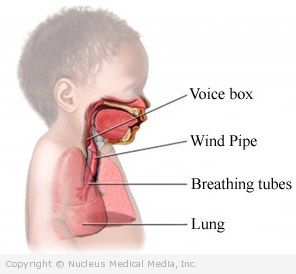Croup – Laryngotracheobronchitis
Croup – Definition
Croup is swelling in the voice box and windpipe. The swelling can make it difficult to breathe and cause a telltale barking cough. Croup occurs most often in children 6 months to 3 years of age. This is due to smaller airway in young children. Airway passages become wider as children grow. This decreases the chance of croup in older children and adults.
Croup – Causes
Croup is caused by viral infections such as:
- Parainfluenza
- Paramyxovirus
- Influenza virus type A
- Respiratory syncytial virus
- Adenovirus
- Rhinovirus
- Enterovirus
- Coxsackievirus
- Enteric cytopathogenic human orphan virus
- Reovirus
- Measles virus
Croup – Risk Factors
A risk factor is something that increases your chance of getting a disease or condition. Risk factors for croup include:
- Age: 3 years or younger
- Attending day care
- History of croup
- Family history of croup
- Frequent upper respiratory infections
- Colder months: October through March
Croup – Symptoms
Croup often begins with symptoms similar to an upper respiratory infection. The symptoms can come on suddenly, often at night. The following is list of common croup symptoms:
- Cough spasms
- Cough that sounds like a barking seal
- Hoarseness
- Fever
- A harsh, high-pitched breath sound when your child breathes in, especially when crying or upset
- Troubled breathing, especially breathing in
- Poor appetite and fluid intake
More serious symptoms of croup that may require immediate medical attention include:
- Bluish color of the nails and lips, or around the mouth — This is an absolute emergency. Call 911.
- Decreased alertness — This is also a very serious symptom. Call 911.
- Restlessness or agitation — This can be due to dangerous lack of oxygen.
- Struggling for each breath
- Harsh, high-pitched breath sounds even at rest
- Trouble swallowing
- Drooling
- Inability to speak due to trouble breathing
- Nausea and vomiting
- Dizziness or lightheadedness
- Rapid, irregular heartbeat; chest pain
- Rash or hives
- High fever
Croup – Diagnosis
The doctor will ask about your child’s symptoms and medical history. A physical exam will be done.
Tests are not always needed. If croup is severe or not clear, your doctor may request:
- Blood tests — to check for signs of infection
- Neck x-rays — to look for changes associated with croup
- Laryngoscopy — a thin tube inserted into the mouth to look at throat tissue. A culture of mucus from the windpipe may be taken during this procedure and tested for infection.
Croup – Treatment
The goal is to keep the airway open until the infection clears. The infection causing croup will resolves on its own in 5-7 days. Severe symptoms usually resolve in 3-4 days.
If your child is diagnosed with croup, follow your doctor’s instructions. Treatments options include:
Home Care
Your child may have trouble sleeping because of breathing difficulties. Moist air may help your child breathe easier. The following methods may help:
- Use a cool humidifier in the bedroom.
- Use the bathroom as a steamroom. Bring your child into the bathroom and close the door. Turn the shower on the hottest setting. Sit in the steamy bathroom with your child. Your child’s breathing should improve within 15-20 minutes.
- Cool night air may also help. Sit with your child near an open a window or step outside.
Make sure your child has plenty of fluids. Opt for water and unsweetened juices.
Medication
The doctor may recommend medicine such as:
- Acetaminophen or ibuprofen — to ease discomfort, follow instructions on bottle
- Steroids — to reduce swelling in the airways, may keep a child from becoming sick enough to need hospitalization
- Racemic epinephrine — delivered through breathing treatments for temporary help until steroid medications start to work
- Anitbiotics — not helpful against virus causing croup but may be needed if there is accompanying problem like an ear infection or pneumonia
Hospital Care
For serious croup your child may need to be hospitalized. Hospital care may include:
- Croup tent — a cool, moist air delivered inside a plastic tent
- Medications or breathing treatments — to treat inflammation and respiratory distress
- Breathing tube — inserted in the throat to help keep the airway open in children that are struggling to breathe
- IV Fluids — given directly into a vein
- Monitoring oxygen level and heart rhythms
- Tracheotomy — a surgical breathing to open the airway in children with severe breathing problems
Croup – Prevention
Croup usually occurs due to an upper respiratory infection. Take steps to decrease your child’s chance of catching colds and flu. Wash your hands often. Avoid contact with people that have cold or flu when possible.
Yearly influenza immunization can prevent those cases of croup due to Influenza A. Influenza immunization is strongly recommended for all children between the ages of 6 months to 5 years.

